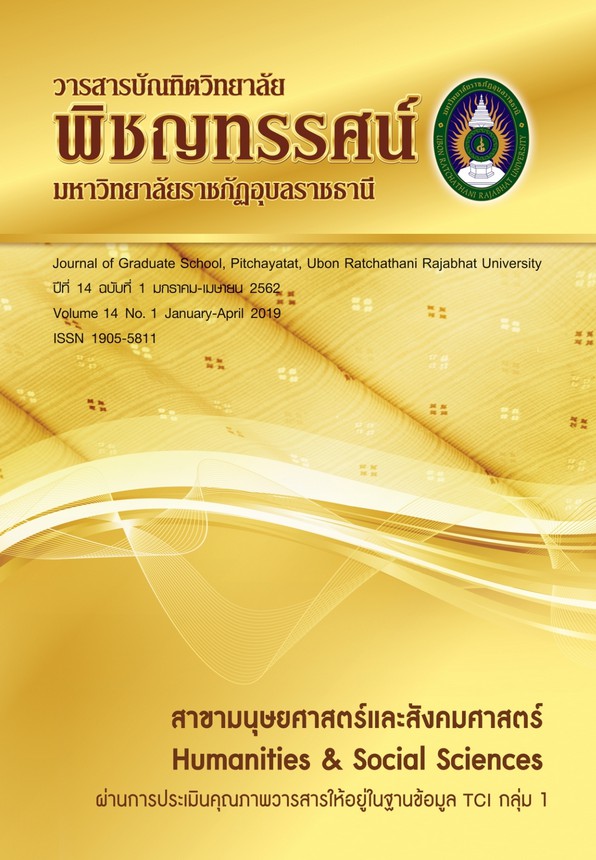รูปแบบการพัฒนาสมรรถนะนักศึกษาครูในการเตรียมฝึกปฏิบัติการสอน โดยใช้การเสริมสร้างพลังและการจัดการเรียนรู้เชิงรุก : กรณีศึกษามหาวิทยาลัยราชภัฏสกลนคร
คำสำคัญ:
รูปแบบการพัฒนาสมรรถนะ, การเสริมสร้างพลัง, การเรียนรู้เชิงรุกบทคัดย่อ
การวิจัยครั้งนี้ มีจุดมุ่งหมายหลักเพื่อพัฒนาและศึกษาผลการทดลองใช้รูปแบบการพัฒนาสมรรถนะนักศึกษาครูในการเตรียมฝึกปฏิบัติการสอน โดยใช้การเสริมสร้างพลังและการจัดการเรียนรู้เชิงรุก กรณีศึกษามหาวิทยาลัยราชภัฏสกลนคร โดยการดำเนินการวิจัยมี 4 ขั้นตอน คือ 1) ศึกษาองค์ประกอบของสมรรถนะนักศึกษาครูในการเตรียมฝึกปฏิบัติการสอน 2) ศึกษาความต้องการจำเป็นในการพัฒนาสมรรถนะ 3) สร้างและประเมินความเหมาะสมของรูปแบบ และ 4) ศึกษาผลการทดลองใช้รูปแบบ กลุ่มตัวอย่างทดลองใช้รูปแบบเป็นนักศึกษาครูชั้นปีที่ 4 มหาวิทยาลัยราชภัฏสกลนคร ปีการศึกษา 2560 จำนวน 87 คน เครื่องมือวิจัย ได้แก่ แบบสอบถามสภาพคาดหวังและสภาพที่มีอยู่จริงเกี่ยวกับสมรรถนะในการเตรียมฝึกปฏิบัติการสอน เอกสารรูปแบบ แผนการจัดการเรียนรู้ แบบทดสอบสมรรถนะด้านความรู้ แบบประเมินสมรรถนะด้านทักษะการปฏิบัติงาน และแบบวัดคุณลักษณะที่เอื้อต่อการปฏิบัติงาน สถิติที่ใช้ในการวิเคราะห์ข้อมูล ได้แก่ ร้อยละ ค่าเฉลี่ย ส่วนเบี่ยงเบนมาตรฐาน ดัชนีความต้องการจำเป็นแบบปรับปรุง การทดสอบทีชนิดกลุ่มเดียวเทียบกับเกณฑ์ และการทดสอบทีชนิดสองกลุ่มไม่อิสระกัน ผลการวิจัยมีดังนี้ 1. รูปแบบที่พัฒนาขึ้น มี 8 องค์ประกอบ คือ 1) ที่มาและความสำคัญ 2) จุดมุ่งหมาย 3) แนวคิดพื้นฐาน 4) หลักการ 5) กรอบสมรรถนะ 6) โครงสร้างเนื้อหา 7) กระบวนการพัฒนาสมรรถนะ และ 8) การวัดและประเมินผล โดยที่ กรอบสมรรถนะแบ่งเป็น 3 ด้าน คือ 1) ด้านความรู้ 7 สมรรถนะ 27 ตัวบ่งชี้ 2) ด้านทักษะการปฏิบัติงาน 7 สมรรถนะ 23 ตัวบ่งชี้ และ 3) ด้านคุณลักษณะที่เอื้อต่อการปฏิบัติงาน 3 สมรรถนะ 20 ตัวบ่งชี้ โครงสร้างเนื้อหา มี 7 หน่วยการเรียนรู้ คือ 1) การจัดการเรียนรู้ที่เน้นผู้เรียนเป็นสำคัญ 2) การวัดและประเมินผลการเรียนรู้ 3) นวัตกรรม การเรียนการสอนเพื่อส่งเสริมการเรียนรู้ 4) การออกแบบหน่วยการเรียนรู้ 5) การจัดทำแผนการจัดการเรียนรู้ 6) การวิจัยปฏิบัติการในชั้นเรียน และ 7) การจัดทำโครงการพัฒนาผู้เรียน ส่วนกระบวนการการจัดการเรียนรู้เพื่อพัฒนาสมรรถนะ มี 5 ขั้น คือ 1) สร้างพลังใจ 2) สร้างพลังความรู้ 3) สร้างพลังปฏิบัติงาน 4) สะท้อนและปรับปรุงการปฏิบัติงาน และ 5) สร้างความมั่นใจในการประยุกต์ใช้ประสบการณ์ ซึ่งผลการประเมินรูปแบบโดยผู้เชี่ยวชาญ พบว่า มีความเหมาะสมอยู่ในระดับมากที่สุด 2. ผลการทดลองใช้รูปแบบ พบว่า 1) นักศึกษาครูมีสมรรถนะด้านความรู้หลังการทดลองใช้รูปแบบสูงกว่า ก่อนการทดลอง และสูงกว่าเกณฑ์ที่ตั้งไว้ที่ร้อยละ 70 อย่างมีนัยสำคัญทางสถิติที่ระดับ .01 2) นักศึกษาครูที่ได้รับ การทดลองใช้รูปแบบ มีสมรรถนะด้านทักษะการปฏิบัติงานสูงกว่าเกณฑ์ที่ตั้งไว้ที่ร้อยละ 70 อย่างมีนัยสำคัญทางสถิติ ที่ระดับ .01 และ 3) นักศึกษาครู มีสมรรถนะด้านคุณลักษณะที่เอื้อต่อการปฏิบัติงานหลังการทดลองใช้รูปแบบสูงกว่าก่อนการทดลอง อย่างมีนัยสำคัญทางสถิติที่ระดับ .01
เอกสารอ้างอิง
คณะครุศาสตร์ มหาวิทยาลัยราชภัฏสกลนคร. คู่มือฝึกปฏิบัติการสอนในสถานศึกษา 1-2. สกลนคร: คณะครุศาสตร์ มหาวิทยาลัยราชภัฏสกลนคร, 2559.
จิราวรรณ นาคพัฒน์. ผลของการเสริมพลังอำนาจ โดยการพัฒนาด้านการออกแบบและจัดการเรียนรู้. วิทยานิพนธ์ครุศาสตรมหาบัณฑิต จุฬาลงกรณ์ มหาวิทยาลัย, 2547.
ทิพวรรณ ภัทรนุสรณ์. อิทธิพลของการเสริมพลังอำนาจครูที่มีต่อของผลผลิตของการวิจัยปฏิบัติการในชั้นเรียน. วิทยานิพนธ์ครุศาสตรมหาบัณฑิต จุฬาลงกรณ์ มหาวิทยาลัย, 2556.
ทิศนา แขมมณี. ศาสตร์การสอน: องค์ความรู้เพื่อจัดกระบวนการเรียนรู้ที่มีประสิทธิภาพ. พิมพ์ครั้งที่ 19. กรุงเทพฯ: สำนักพิมพ์แห่งจุฬาลงกรณ์มหาวิทยาลัย, 2558.
นรินทร์ วงค์คำจันทร์. การศึกษาความคิดสร้างสรรค์ทางวิทยาศาสตร์และผลสัมฤทธิ์ทางการเรียนวิทยาศาสตร์ของนักเรียนระดับชั้นมัธยมศึกษาปีที่ 2 ด้วยการจัดการเรียนรู้เชิงรุก. วิทยานิพนธ์ ศึกษาศาสตรมหาบัณฑิต มหาวิทยาลัยรามคำแหง, 2558.
พิพัฒน์ อัฒพุธ. ผลการใช้สื่อสังคมออนไลน์ร่วมกับการเรียนรู้เชิงรุก วิชาการออกแบบและผลิตสื่อกราฟิกคอมพิวเตอร์ สำหรับนักศึกษาระดับชั้นปริญญาตรี. วิทยานิพนธ์การศึกษามหาบัณฑิต มหาวิทยาลัยนเรศวร, 2558.
มณีรัตนา โนนหัวรอ. พัฒนารูปแบบการประเมินเสริมพลัง เพื่อเพิ่มสมรรถนะด้านการวัดและประเมินผลการศึกษาของครูประจำการสังกัดสำนักงานเขตพื้นที่การศึกษาประถมศึกษาปราจีนบุรี เขต 2. การศึกษาดุษฎีบัณฑิต มหาวิทยาลัยศรีนครินทรวิโรฒ, 2557.
ยุวธิดา ชาปัญญา. การเสริมสร้างพลังอำนาจของครูในโรงเรียนประถมศึกษา: การวิจัยทฤษฎีฐานราก. วิทยานิพนธ์ปรัชญาดุษฎีบัณฑิต มหาวิทยาลัยขอนแก่น, 2554.
วาสนา เจริญไทย. ผลการจัดกิจกรรมการเรียนรู้เชิงรุกที่มีต่อผลสัมฤทธิ์ทางการเรียน และความสามารถในการแก้โจทย์ปัญหาทางคณิตศาสตร์ เรื่อง เศษส่วน ของนักเรียนชั้นมัธยมศึกษาปีที่ 1. วิทยานิพนธ์วิทยาศาสตร มหาบัณฑิต มหาวิทยาลัยบูรพา, 2557.
สุรสิทธิ์ สิทธิอมร. การพัฒนาสมรรถนะด้านการวิจัยและพัฒนา ด้วยการเสริมเสริมสร้างพลังและการรับรู้ความสามารถตน สำหรับครูมัธยมศึกษา. วิทยานิพนธ์ปรัชญาดุษฎีบัณฑิต มหาวิทยาลัยราชภัฏสกลนคร, 2558.
สุวิมล ว่องวาณิช. การวิจัยประเมินความต้องการจำเป็น. พิมพ์ครั้งที่ 2. กรุงเทพฯ: สำนักพิมพ์แห่งจุฬาลงกรณ์มหาวิทยาลัย, 2550.
อาภาพร สิงหราช. พัฒนารูปแบบการเสริมสร้างพลังอำนาจในการทำงานของครูด้วยแนวคิดนีโอฮิวแมนนิส เพื่อพัฒนาความสามารถในการจัดการเรียนรู้ที่เน้นผู้เรียนเป็นสำคัญ. วิทยานิพนธ์ดุษฎีบัณฑิต จุฬาลงกรณ์มหาวิทยาลัย, 2552.
Orhan and Ruhan. The effect of problem-based active learning in Science education on students’ academic achievement, attitude and concept learning. Eurasia Journal of Mathematics, Science & Technology Education. 3, 1 (2007): 71-81.
ดาวน์โหลด
เผยแพร่แล้ว
รูปแบบการอ้างอิง
ฉบับ
ประเภทบทความ
สัญญาอนุญาต
บทความทุกเรื่องได้รับการตรวจความถูกต้องทางวิชาการโดยผู้ทรงคุณวุฒิภายนอกอย่างน้อย 3 คน ความคิดเห็นในวารสารพิชญทรรศน์เป็นความคิดเห็นของผู้นิพนธ์มิใช่ความคิดเห็นของผู้จัดทำ จึงมิใช่ความรับผิดชอบของวารสารพิชญทรรศน์ และบทความในวารสารพิชญทรรศน์สงวนสิทธิ์ตามกฎหมายไทย การจะนำไปเผยแพร่ต้องได้รับอนุญาตเป็นลายลักษณ์อักษรจากกองบรรณาธิการ





